Architecture Home Styles
Top 5 Trendy Internal Doors for Modern Homes
Boldly step into the world of modern home design with these top 5 trendy internal doors that redefine elegance and functionality.
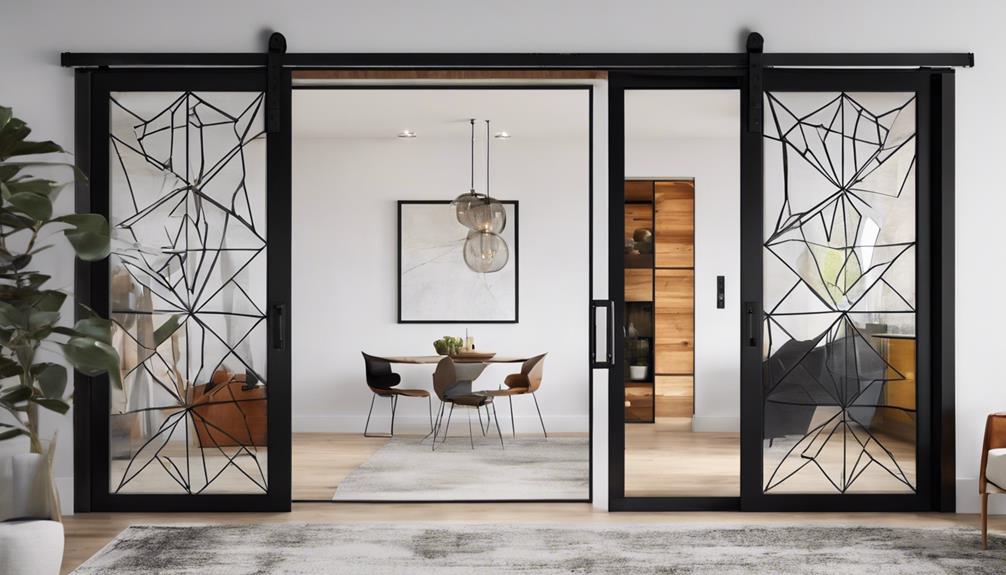
As we open the door to the world of modern home design, we find ourselves faced with a myriad of stylish options that can truly transform a living space.
These top 5 trendy internal doors offer not just functionality but also a touch of sophistication that elevates the ambiance of any home.
From sleek sliding doors to elegant glass panel doors, each style brings its own unique charm to the forefront.
Join us as we explore these contemporary door designs that are redefining the concept of interior aesthetics.
Key Takeaways
- Sliding doors and glass panel doors flood rooms with natural light, creating a bright and airy atmosphere.
- Barn doors infuse spaces with character and charm, serving as a stylish focal point.
- Minimalist flush doors offer a seamless and simplistic design with natural wood finishes.
- Pivot doors revolutionize modern home entrances, providing functionality and style for rooms of all sizes.
Sliding Doors
When it comes to modern interior design, sliding doors effortlessly blend functionality with chic sophistication. These doors are a staple in contemporary design, offering a seamless way to connect spaces while adding a touch of elegance. One of the key benefits of sliding doors is their ability to allow natural light to flood into a room, creating a bright and airy atmosphere. This not only enhances the overall aesthetic but also makes the space feel more inviting and spacious.
Moreover, sliding doors are incredibly easy to install, making them a practical choice for those looking to update their home decor without the hassle of extensive renovations. Whether you have a large living area or a cozy bedroom, sliding doors can be customized to fit any space, making them a versatile option for any home. By incorporating sliding doors into your interior design, you can effortlessly elevate the style and functionality of your living spaces.
Glass Panel Doors
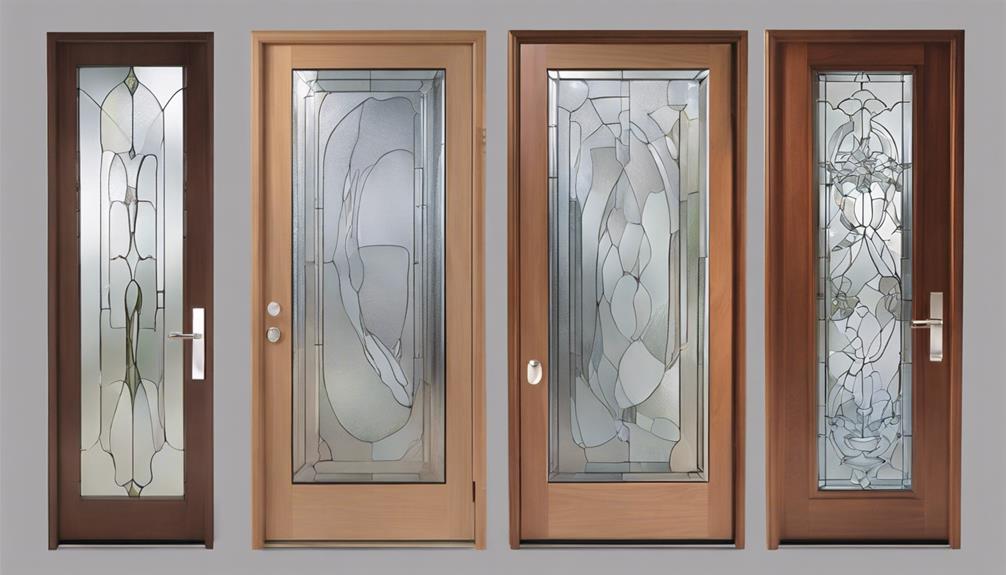
Effortlessly infusing modern spaces with a sleek and sophisticated allure, glass panel doors are a stylish addition to interior design. These contemporary doors with glass panels not only bring a touch of elegance but also serve a functional purpose. By allowing natural light to flow through, they create a bright and airy atmosphere, making rooms feel more spacious and inviting. With various styles and designs available, glass panel doors can easily complement different decor preferences, from minimalist to more ornate interiors.
Ideal for spaces where visibility is desired, such as home offices or areas that require a sense of openness, these high interior doors are both practical and aesthetically pleasing. Whether you prefer a single glass panel or multiple panels with intricate patterns, glass panel doors can elevate the ambiance of any room they adorn. Embracing the trend of modern interior design, these doors offer a contemporary twist that suits the preferences of those seeking a chic and liberating home environment.
Barn Doors
With their rustic charm and versatile appeal, barn doors effortlessly infuse any room with character and style, making them a popular choice for modern interior design. Barn doors aren't just a door; they're a statement piece that adds flair to contemporary interiors. These doors blend seamlessly with various design styles, from industrial to farmhouse chic, making them a versatile option for homeowners seeking a unique touch.
The space-saving design of barn doors is perfect for rooms where traditional swing doors might be cumbersome. Their distinctive look serves as a focal point in any space, elevating the overall aesthetic with a touch of warmth and personality. Whether used to separate rooms or conceal storage areas, barn doors bring a sense of nostalgia and charm to modern living spaces. Embrace the trend of barn doors to create a stylish and functional element within your Contemporary Interior.
Minimalist Flush Doors
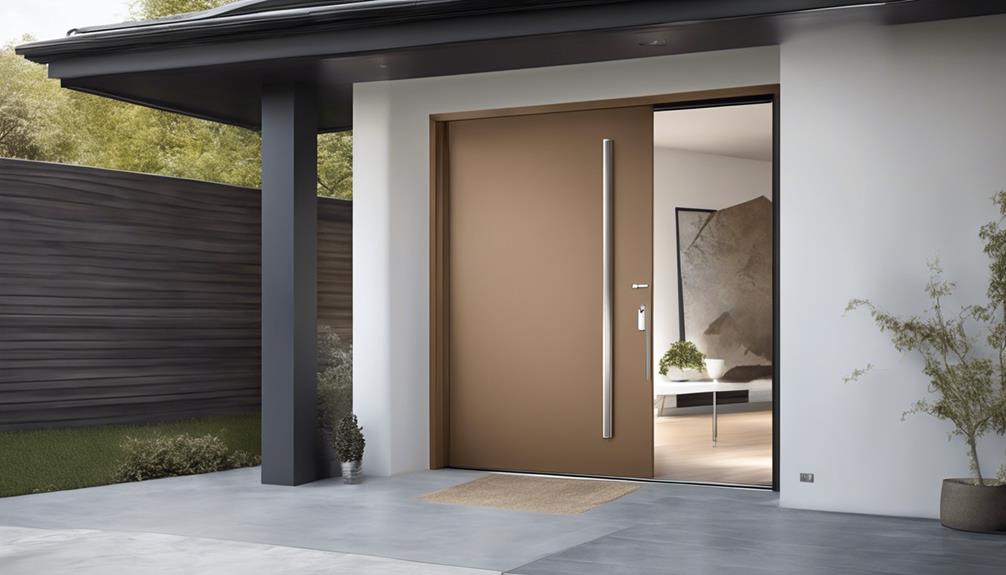
Incorporating a sleek and modern touch to contemporary interiors, minimalist flush doors are a popular choice known for their simplistic design. These doors offer a seamless appearance that blends effortlessly with modern interior design styles.
Here are key points to consider about minimalist flush doors:
- Simplicity at Its Best: Minimalist flush doors feature plain facings on both sides, making them a perfect fit for room passages where a clean and uncluttered look is desired.
- Durable and Trendy: Interior design experts hail minimalist flush doors as durable and trendy choices for modern homes, adding both style and functionality to living spaces.
- Natural Wood Finishes: Opting for natural wood finishes enhances the minimalist appeal of these doors, bringing a touch of warmth and sophistication to any room.
- Seville Pre-Finished Oak Option: One popular example is the Seville Pre-Finished Oak Internal Door, showcasing the beauty of natural wood in a minimalist design.
Pivot Doors
Pivot doors revolutionize modern home entrances with their striking design and unique rotational feature, elevating the overall aesthetic appeal of any living space. These interior design marvels offer a seamless blend of functionality and style, making them a popular choice for those seeking to make a statement with their home decor. Pivot doors not only provide a high level of ergonomics by allowing for easy passage, but their versatility in design caters to rooms of various sizes and layouts.
Their ability to create different atmospheres within a space adds a touch of sophistication that's unmatched by traditional door styles. Whether you prefer a sleek and modern look or a more rustic and cozy feel, pivot doors can be customized to suit your personal taste and interior design preferences. With their ability to enhance the overall ambiance of a room, pivot doors are a must-have for homeowners looking to elevate their living spaces with a touch of contemporary flair.
Frequently Asked Questions
What Is the Most Popular Interior Door Style in 2023?
The most popular interior door style in 2023 is the Raised 6 Panel Door. It's part of the 100 door series and offers various panel options.
Among this series, the 108 door is the top choice, commonly seen in homes. This door style is favored for its timeless appeal, versatility, and ability to complement different interior design themes.
Homeowners love it for its aesthetic charm and widespread availability.
What Is the Current Trend for Internal Doors?
We've noticed a surge in demand for sleek and versatile internal doors that seamlessly blend with modern home aesthetics. Homeowners are gravitating towards designs that maximize space and light, such as bifold and French doors.
The trend leans towards minimalist styles that enhance the overall ambiance of a living space. Functionality, aesthetics, and practicality are key factors influencing the current choices in internal doors for modern homes.
What Is the Trend in Interior Doors in 2024?
We've delved into the vibrant world of interior design trends in 2024 and uncovered a treasure trove of style and sophistication just waiting to adorn modern homes.
The allure of interior doors this year lies in their ability to seamlessly blend functionality with artistic flair, creating a harmonious balance that captivates the eye and elevates the ambiance of any living space.
Stay tuned for a peek into the enchanting realm of 2024 interior door trends!
What Is the Most Popular Style of Interior Doors?
The most popular style of interior doors is the Raised 6 Panel Door, offering a range of panel options with the 108 door being the most sought after.
It's a classic choice found in many homes and part of the 100 door series. Its versatility and timeless appeal make it a top choice for homeowners looking for a stylish and adaptable option to elevate their living spaces.
Conclusion
In conclusion, when it comes to trendy internal doors for modern homes, we can't overlook the sleek Sliding Doors, the elegant Glass Panel Doors, the rustic charm of Barn Doors, the minimalist appeal of Flush Doors, and the innovative Pivot Doors.
These doors not only enhance the aesthetics of our living spaces but also offer practical benefits. So, why not spruce up your home with one of these stylish selections today?
- About the Author
- Latest Posts
Introducing Ron, the home decor aficionado at ByRetreat, whose passion for creating beautiful and inviting spaces is at the heart of his work. With his deep knowledge of home decor and his innate sense of style, Ron brings a wealth of expertise and a keen eye for detail to the ByRetreat team.
Ron’s love for home decor goes beyond aesthetics; he understands that our surroundings play a significant role in our overall well-being and productivity. With this in mind, Ron is dedicated to transforming remote workspaces into havens of comfort, functionality, and beauty.
Architecture Home Styles
European Home Vs American Home: Contrasting Architectural Styles
A captivating exploration of the contrasting architectural styles between European and American homes will leave you intrigued and eager to discover more.
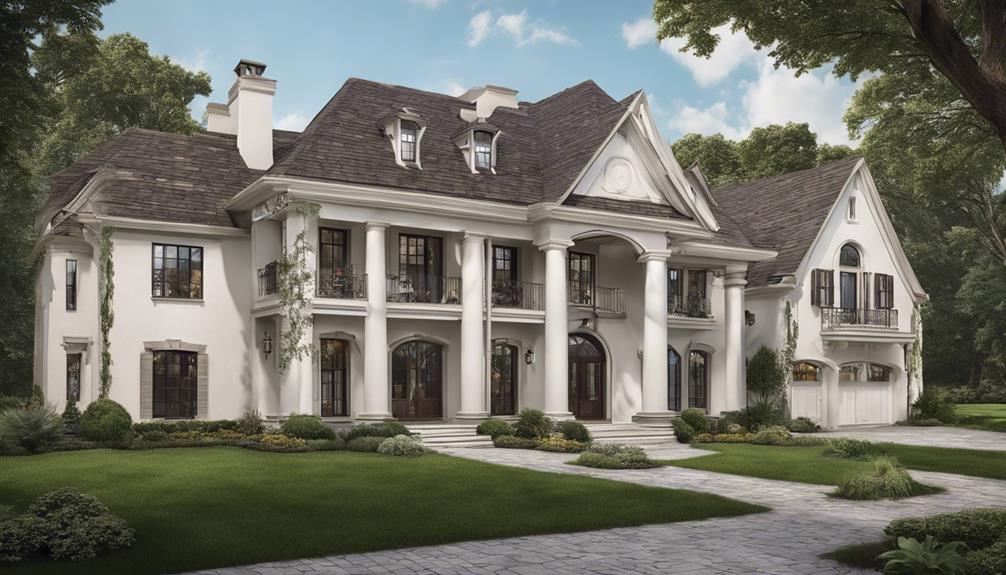
When strolling through the charming streets of Amsterdam, one cannot help but notice the quaint row houses with their unique gabled facades. These architectural marvels stand in stark contrast to the sprawling suburban homes found in the heart of America.
As we explore the differences between European and American home styles, we uncover a fascinating array of influences that shape the way we live and interact with our surroundings. From the materials used in construction to the layout of the interior spaces, each architectural choice tells a story of tradition and innovation, sparking a compelling dialogue on the essence of home design.
Key Takeaways
- European homes emphasize energy efficiency and communal living, while American homes prioritize traditional aesthetics and outdoor spaces.
- European homes feature compact designs with stone walls, wood roofs, and smaller plots, contrasting with American homes' larger dimensions and brick walls.
- European governments enforce strict regulations for energy-efficient homes, resulting in lower utility costs compared to less efficient American homes.
- Both European and American homes are adapting to modern lifestyle needs, blending open living spaces with traditional design elements for personalized living environments.
Property Size Differences
Comparing European and American home architectural styles reveals distinct differences in property sizes, reflecting cultural priorities and lifestyle preferences. American homes tend to be larger, often boasting multiple bedrooms and spacious yards, catering to the desire for ample living space and outdoor areas. In contrast, European homes are more compact and easier to maintain, typically featuring one or two bedrooms and smaller plots of land. This disparity in property size between American and European homes underscores the cultural variations in housing preferences.
American homes prioritize the accommodation of larger families with more bedrooms and bathrooms, while European homes emphasize efficient use of space with fewer rooms. The larger yards commonly found in American homes contrast with the smaller outdoor areas of European homes, illustrating the differing attitudes towards outdoor living and property maintenance. Ultimately, the property size variances between American and European homes highlight the importance of space and practicality in shaping architectural styles on both sides of the Atlantic.
Materials and Construction Variances

The choice of materials and construction techniques significantly distinguishes European and American home architectural styles, showcasing varying approaches to durability, aesthetics, and energy efficiency. European homes commonly utilize stone walls and wood roofs for insulation, emphasizing energy efficiency and a rustic charm. In contrast, American homes often feature brick walls and shingle roofs, providing a more traditional and classic appearance. Both European and American homes share a preference for granite kitchen countertops, while differing in flooring choices – European homes favor stone or marble floors for a touch of elegance, whereas American homes frequently opt for tile floors. However, wooden flooring is a common feature in both architectural styles, adding warmth and versatility to the interior spaces. European homes prioritize better insulation and energy efficiency through their construction materials and techniques, setting them apart in sustainable living practices.
| European Homes | American Homes |
|---|---|
| Stone walls, wood roofs | Brick walls, shingle roofs |
| Stone or marble flooring | Tile floors |
| Emphasis on energy efficiency | Traditional aesthetics |
| Rustic charm | Classic appearance |
Lifestyle and Cultural Influences
European homes, in contrast to American homes, often reflect a more communal lifestyle and cultural influence in their designs and layouts. This difference is evident in various aspects of the homes:
- Community Focus: European homes are designed to promote a sense of community living, with communal elements like parks and green spaces integrated into the neighborhoods.
- Isolation vs. Communal Living: American homes tend to prioritize isolationist designs, often found in gated communities, while European homes emphasize shared spaces and interactions among neighbors.
- Design Philosophy: European homes incorporate communal areas and green spaces into their design, encouraging social interactions and a sense of belonging within the community.
- Cultural Influences: The cultural emphasis on community and social connections in Europe influences the design of homes, fostering a more interconnected and social lifestyle compared to the more individualistic American approach.
These differences in design and lifestyle preferences between American and European homes highlight the cultural influences shaping architectural styles on both continents.
Energy Efficiency Contrasts

Prioritizing energy efficiency in home design, especially in insulation and sustainable practices, reveals a notable contrast between European and American architectural styles. Europeans prefer smaller, more compact homes that are inherently more energy-efficient due to better insulation standards. European governments have imposed strict regulations promoting energy efficiency in residential buildings, leading to reduced energy consumption and lower utility costs for homeowners.
In contrast, American homes, characterized by their larger dimensions and open layouts, tend to be less energy-efficient, resulting in higher energy consumption and utility bills. The emphasis on energy efficiency in European homes is evident in the meticulous attention to detail in insulation and sustainable design practices, reflecting a commitment to reducing environmental impact.
Floor Plans and Layout Disparities
In the realm of home design, distinctions in floor plans and layout preferences between European and American architectural styles are prominently showcased. When comparing European and American floor plans, several key differences emerge:
- Open Living Spaces: American homes typically feature open living spaces where the kitchen, living, and dining areas flow seamlessly into one another, promoting a sense of spaciousness and connectivity.
- Room Separation: In contrast, European homes traditionally favor separate rooms for specific functions, although there's a growing trend towards more open-plan designs to cater to modern lifestyle needs.
- Kitchen Designs: European kitchens are often compact and distinct spaces with frameless cabinets, while American kitchens tend to be larger, equipped with framed cabinets, and showcase bigger appliances, reflecting cultural nuances and preferences.
- Customization: Advanced design software like Foyr Neo allows homeowners to personalize their floor plans according to individual tastes, blending elements of both European and American styles to create a unique living space that suits their needs and aesthetic preferences.
Frequently Asked Questions
What Is the Difference Between American and European Architecture?
When comparing American and European architecture, we notice distinct differences.
While American homes often feature brick walls and shingle roofs, European architecture leans towards stone walls and wood roofs for better insulation.
Americans typically prefer open-floor plans, while Europeans opt for more compartmentalized living spaces.
Energy efficiency is a key focus in European homes, which are usually smaller and more sustainable.
These contrasting architectural styles reflect cultural preferences and design priorities.
What Is the Difference Between American Homes and European Homes?
When comparing American homes to European homes, we notice distinct differences in architectural styles, size preferences, and design priorities. Americans tend to favor larger homes with numerous bedrooms and bathrooms, whereas Europeans lean towards smaller, more efficient dwellings.
Energy efficiency and sustainability are emphasized in European homes through better insulation and eco-friendly design practices, contrasting with the spacious layouts and isolated living spaces commonly found in American homes.
What Is the Difference Between American Design and European Design?
When it comes to design, American and European styles diverge significantly. American design often prioritizes spaciousness and open layouts, while European design tends to favor compartmentalized rooms.
These differences in architectural philosophy are reflected in the materials used, energy efficiency standards, and overall aesthetic choices. Understanding these distinctions can provide valuable insights into the unique approaches each culture takes towards creating living spaces that suit their respective needs and values.
What Are the Characteristics of a European Style House?
European style houses often feature stone walls and wood roofs for insulation. These homes typically have smaller dimensions with one or two bedrooms and one bathroom. Granite worktops in kitchens and stone or marble flooring are commonly used.
European communities emphasize communal elements like parks and green spaces. Energy efficiency is a priority in European homes, with better insulation and sustainable design practices.
Conclusion
In conclusion, the contrasting architectural styles of European homes and American homes highlight the unique cultural preferences and design trends of each region. From property size differences to materials and construction variances, these homes reflect the values and lifestyles of their inhabitants.
But as we consider these differences, one question arises: how can we blend the best of both worlds to create a truly harmonious and sustainable living environment?
- About the Author
- Latest Posts
Introducing Ron, the home decor aficionado at ByRetreat, whose passion for creating beautiful and inviting spaces is at the heart of his work. With his deep knowledge of home decor and his innate sense of style, Ron brings a wealth of expertise and a keen eye for detail to the ByRetreat team.
Ron’s love for home decor goes beyond aesthetics; he understands that our surroundings play a significant role in our overall well-being and productivity. With this in mind, Ron is dedicated to transforming remote workspaces into havens of comfort, functionality, and beauty.
Architecture Home Styles
Best Places to Travel for Architecture Enthusiasts
Prepare to be mesmerized by the architectural wonders of the world as we unveil the hidden gems and iconic landmarks that define the best places to visit for architecture enthusiasts.

As we step into the realm of architectural wonders, our senses are transported through time and space, encountering a blend of history and innovation in each corner of the globe.
Exploring the intricate details of ancient ruins in Rome to the sleek lines of contemporary structures in Tokyo, the journey for architecture enthusiasts is nothing short of a visual feast.
But what sets apart the truly exceptional destinations for those who appreciate the art of design? Let's uncover the hidden gems and iconic landmarks that define the best places to visit for architecture enthusiasts, where each building tells a story waiting to be unraveled.
Key Takeaways
- Explore European cities for rich history and diverse architectural styles.
- Discover modern wonders in cities like Dubai and Singapore with futuristic designs.
- Immerse in classical treasures in Athens, Rome, and Istanbul for ancient architectural marvels.
- Uncover architectural gems worldwide, from Quito to Bengaluru, blending tradition and innovation.
European Architectural Marvels
In exploring European Architectural Marvels, we delve into a rich tapestry of history, innovation, and artistic expression found in iconic cities across the continent. Barcelona stands out for its Catalan Modernism, exemplified by the breathtaking Sagrada Familia cathedral designed by the visionary Antoni Gaudi. This masterpiece blends Gothic and Art Nouveau styles, captivating visitors with its intricate facades and towering spires.
Moving to Italy, Florence boasts the stunning Florence Cathedral, a marvel of Renaissance architecture that showcases intricate details and a majestic dome. The Uffizi Gallery, also in Florence, is a treasure trove of artistic wonders housed within an architectural gem.
Rome, on the other hand, takes us back to ancient times with its Roman architecture epitomized by the grand Colosseum and the enduring Roman Pantheon. Meanwhile, Venice's unique blend of Venetian Gothic and Renaissance styles shines in landmarks like St. Mark's Basilica, a symbol of the city's rich architectural heritage.
Modern Architectural Wonders

Dubai's Burj Khalifa, standing as the world's tallest building, exemplifies futuristic and contemporary architectural brilliance. Its sleek design and advanced engineering make it a true icon of modern architecture.
Moving on to the Sydney Opera House in Australia, this iconic structure nestled against the harbor is a masterpiece of contemporary design. The unique sail-like roofs create a striking silhouette that has captivated visitors for decades.
Transitioning to the Guggenheim Museum in Bilbao, Spain, designed by Frank Gehry, we encounter a prime example of modernism. Its fluid forms and unconventional materials challenge traditional architectural norms, pushing boundaries and inspiring awe.
In Singapore, the Marina Bay Sands showcases innovative design with its iconic rooftop pool, a symbol of neo-futurism.
Lastly, the Museum of the Future in Dubai represents a cutting-edge architectural masterpiece, embodying the essence of neo-futurism with its striking and visionary design.
These modern architectural wonders stand as testaments to human creativity and ingenuity in the contemporary era.
Classical Architectural Treasures
Exploring classical architectural treasures around the world unveils a rich tapestry of historical and cultural significance that continues to awe and inspire enthusiasts of timeless design.
Athens, Greece, is a testament to ancient Greek architecture, boasting temples supported by majestic columns dating back to 400 BC.
In Barcelona, Spain, the Catalan Modernism style shines through landmarks like the iconic Sagrada Familia, a masterpiece influenced by the visionary architect Antoni Gaudi.
Rome, Italy, captivates with ancient Roman architectural wonders such as the awe-inspiring Colosseum and the historic Roman Forum, showcasing the grandeur of the past.
Istanbul, Turkey, presents a fusion of Byzantine and Ottoman architecture in structures like the magnificent Hagia Sophia and the elegant Blue Mosque.
Venice, Italy, stands out for its distinctive Venetian Gothic and Renaissance architecture, epitomized by the stunning St. Mark's Basilica.
Each of these destinations offers a glimpse into the beauty and craftsmanship of classical architecture, inviting visitors to marvel at the enduring legacy of these architectural treasures.
Futuristic Architectural Landmarks

Showcasing cutting-edge designs and innovative concepts, futuristic architectural landmarks redefine the skyline of modern cities worldwide. In Dubai, the Burj Khalifa stands tall as the world's tallest building, a symbol of futuristic architecture. Singapore's Marina Bay Sands impresses with its neo-futuristic design, featuring the iconic rooftop infinity pool that blends innovative design seamlessly. San Francisco's Salesforce Tower is a prime example of neo-futurism, boasting a sleek and modern aesthetic that captures the essence of innovative architecture.
The Museum of the Future in Dubai takes architectural concepts to new heights by seamlessly integrating technology and design, creating a space that pushes boundaries and sparks creativity. In Singapore, the Interlace redefines urban living spaces with its interconnected and futuristic design, offering residents a unique and innovative way of experiencing city life. These landmarks not only showcase the possibilities of futuristic architecture but also inspire future generations to think outside the box when it comes to architectural design.
Architectural Gems Across Continents
Have you ever marveled at the blend of colonial and modernist architectural styles in Quito, Ecuador's captivating attractions? Quito boasts a mix of traditional and contemporary elements that create innovative architecture across the city. Over 86% of its architectural sites have received high ratings of 4.5 stars or more, making it a must-visit destination for architecture enthusiasts.
Moving across continents, Rio de Janeiro, the first World Capital of Architecture, showcases the iconic Niteroi Contemporary Art Museum, a masterpiece of modern design. Quezon City in the Philippines also stands out for its distinctive architectural sites, drawing praise for its unique blend of styles.
Meanwhile, Bengaluru in India impresses visitors with its fusion of traditional and contemporary architectural elements, offering a fresh perspective on architectural innovation. These architectural gems across continents provide a rich tapestry of diverse styles and inspirations for those seeking out the world's most intriguing architectural sites.
Frequently Asked Questions
Which City Has the Most Interesting Architecture?
We believe that when considering the most interesting architecture in a city, it's essential to examine the fusion of historical significance and modern innovation. Architectural marvels that seamlessly blend tradition with contemporary design captivate our attention and inspire awe.
What Country Has the Prettiest Architecture?
We think Spain has some of the prettiest architecture!
The country boasts a rich mix of styles, from the intricate designs of Antoni Gaudí in Barcelona to the historic charm of cities like Seville and Toledo.
Not to mention the stunning Moorish influences in Granada's Alhambra Palace.
Spain's architectural diversity truly captivates the eye and soul, making it a must-visit for any architecture enthusiast.
What Place in the World Has the Best Architecture?
When we consider the best architecture globally, one must delve into a multitude of factors. Architectural brilliance can be found in diverse locations worldwide, ranging from ancient wonders to contemporary marvels.
The fusion of cultural influences, historical significance, and innovative design all contribute to the beauty of architecture. Exploring these elements in various destinations unveils a rich tapestry of architectural gems waiting to be appreciated.
What Is the Best Country to Work as an Architect?
We find Canada to be a top choice for working as an architect. The country offers a high quality of life and a strong demand for architectural services.
With its robust economy and focus on sustainable design, Germany is another excellent option.
Australia stands out with diverse projects, competitive salaries, and a great work-life balance.
In the United States, the dynamic architectural market provides opportunities across various sectors and regions.
The UK attracts architects worldwide with its rich heritage and iconic projects.
Conclusion
In conclusion, exploring the world's architectural wonders is truly a feast for the eyes and soul. From the intricate details of European marvels to the bold statements of modern wonders, each destination offers a unique perspective on the evolution of design.
As they say, the world is our oyster when it comes to discovering the rich tapestry of architectural gems across continents. So pack your bags and embark on a journey filled with inspiration and awe.
- About the Author
- Latest Posts
Introducing Ron, the home decor aficionado at ByRetreat, whose passion for creating beautiful and inviting spaces is at the heart of his work. With his deep knowledge of home decor and his innate sense of style, Ron brings a wealth of expertise and a keen eye for detail to the ByRetreat team.
Ron’s love for home decor goes beyond aesthetics; he understands that our surroundings play a significant role in our overall well-being and productivity. With this in mind, Ron is dedicated to transforming remote workspaces into havens of comfort, functionality, and beauty.
Architecture Home Styles
Uganda House Build: How Many Cement Bags for 4 Bedrooms
Meticulously calculating cement needs for a 4-bedroom house in Uganda is crucial for a successful build – find out the key factors influencing this estimation.
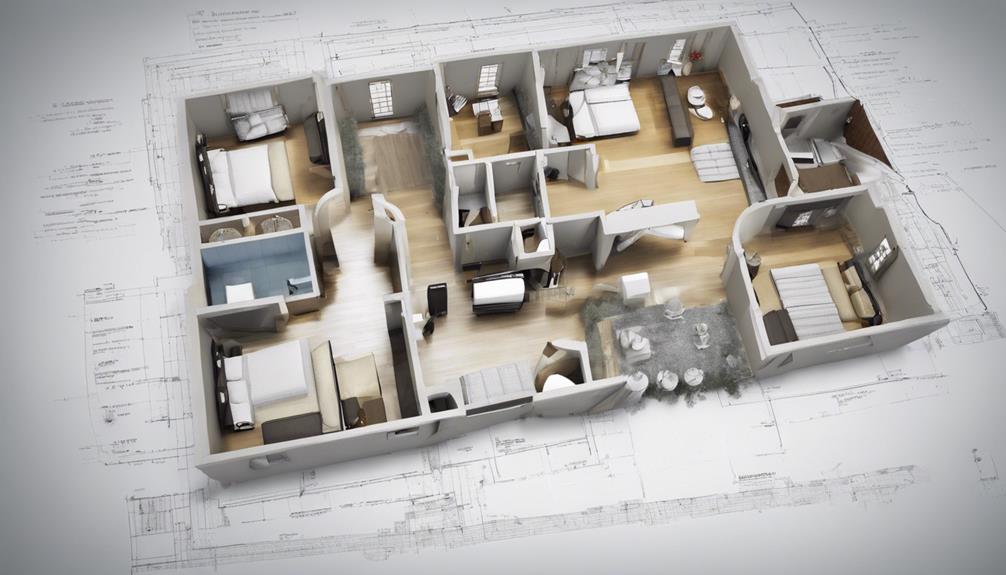
When embarking on a house construction project in Uganda, such as building a 4-bedroom home, the question of how many cement bags to use is a pivotal one. The initial estimation of 112-120 bags can serve as a starting point, but various factors can influence this calculation.
From the quality of cement to the structural design and even the foundation type, each element plays a crucial role in determining the final number of cement bags needed. Understanding these nuances is essential for a successful build that meets both quality standards and budgetary constraints.
Key Takeaways
- Cement quantity crucial for cost efficiency and structural integrity in 4-bedroom builds.
- Proper distribution: 25-30 bags for foundation, 50-60 for walls, 20-25 for beams, and 17-20 for finishing.
- Accurate estimation ensures budgeting precision and minimizes wastage.
- Quality cement choice impacts durability; meticulous planning essential for successful construction.
Cement Bags Calculation for 4-Bedroom House
In calculating the required number of cement bags for a 4-bedroom house construction in Uganda, precision is paramount to ensure cost-effectiveness and structural stability. Construction planning for a four-bedroom house necessitates a meticulous approach to determine the exact quantity of cement needed.
By considering factors such as the type of cement, construction techniques, and structural requirements, we can optimize the number of cement bags required for the project. Efficient allocation of resources, such as cement bags, is essential to minimize wastage and avoid unnecessary expenses.
Careful calculation ensures that the construction process proceeds smoothly and that the structural integrity of the house is maintained throughout. With proper planning and accurate estimation of cement bags, we can streamline the construction timeline and budget effectively.
This focus on detail and precision in cement calculation is key to the success of the 4-bedroom house project in Uganda.
Estimating Cement Bags for 4 Bedrooms
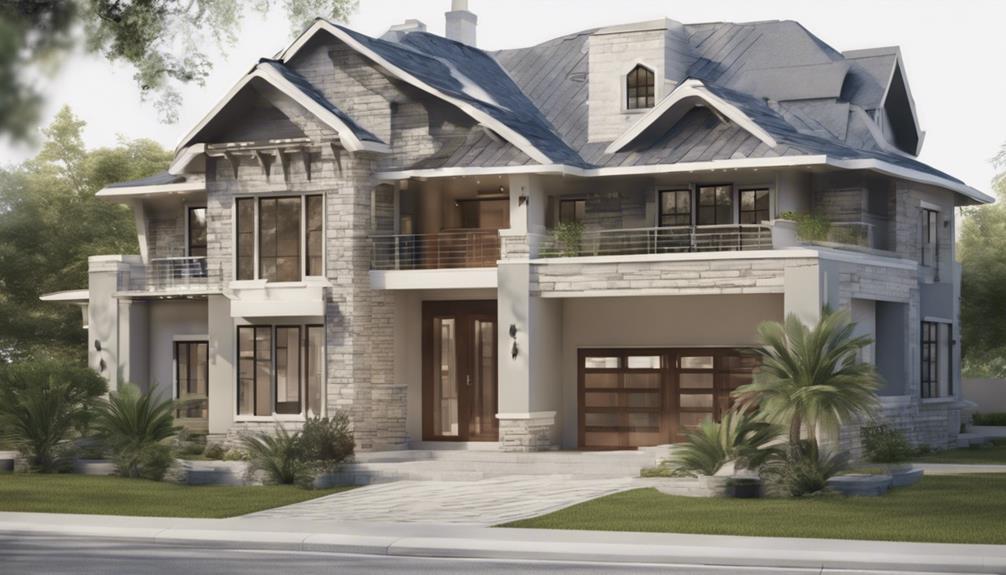
For estimating the required number of cement bags for a 4-bedroom house construction in Uganda, meticulous calculation is essential to ensure cost-effectiveness and structural stability. To assist in this process, we have provided an estimation table below to guide your calculations.
| Cement Type | Estimated Bags Needed | Cost (in Ugandan Shillings) |
|---|---|---|
| Kampala/Simba | 112-120 | 3.4 million |
| Tororo/Hima | 112-120 | 4 million |
| Other | Specific calculations may vary | Varies based on type |
Understanding the precise quantity of cement required is crucial for effective budgeting and timely completion of the construction project. Whether you are constructing bedrooms, a living room, or any other part of the house, accurate estimations ensure that you have the right amount of materials without excess wastage. If you need further assistance with these calculations or have any questions, feel free to contact us.
Quantity of Cement Bags for 4-Bedroom Build
With an estimated requirement of 112-120 bags of cement, the quantity for a 4-bedroom build in Uganda is a crucial factor in ensuring cost efficiency and structural stability. Cement serves as the backbone of any construction project, providing the necessary binding material for structural components.
In the context of a 4-bedroom house, the quantity of cement bags directly impacts the overall budget and the strength of the building. By accurately calculating the required number of cement bags based on the project's scale and design, builders can streamline the procurement process and avoid costly overages or shortages.
Additionally, the quality of cement utilized plays a significant role in the longevity and durability of the structure. Therefore, precise calculations and selection of the appropriate type of cement are paramount for achieving a successful 4-bedroom build in Uganda.
Cement Bags Needed for 4 Bedrooms

To ensure structural integrity and cost efficiency, the required quantity of cement bags for a 4-bedroom construction in Uganda ranges between 112 and 120. Proper allocation of cement bags is crucial to the success of the project.
- Foundation: Approximately 25-30 bags of cement are needed for laying the foundation of a 4-bedroom house. This step is critical for the stability and durability of the entire structure.
- Walls: Allocating around 50-60 bags of cement for the walls ensures strength and resilience. The walls provide support and define the layout of the house.
- Beams: Setting aside 20-25 bags of cement for beams is essential for distributing the load evenly and preventing structural issues over time.
- Finishing: The remaining 17-20 bags of cement can be used for finishing touches like plastering and flooring, adding the final touches to the construction.
Determining Cement Bags for 4-Bedroom House
Calculating the required quantity of cement bags for a 4-bedroom house construction demands meticulous planning and precise estimation. Understanding the specific needs for elements like the foundation, walls, slabs, and beams is crucial for accurate cement calculations. This ensures the structural integrity and durability of the house, essential for long-term stability.
To aid in this process, we have provided a table below showcasing the estimated range of cement bags required for a 4-bedroom house construction alongside the corresponding estimated costs for Kampala/Simba or Tororo/Hima cement. This data serves as a practical guide for budgeting and procurement, facilitating a smoother construction project.
| Cement Bags | Estimated Costs (UGX) |
|---|---|
| 112 | 3,400,000 – 4,000,000 |
| 120 | 3,400,000 – 4,000,000 |
| … | … |
| … | … |
Frequently Asked Questions
How Many Bags of Cement Can Build a 4-Bedroom House in Uganda?
We estimate that building a 4-bedroom house in Uganda typically requires 112-120 bags of cement.
The cost of cement for this project ranges from 3.4 million to 4 million Ugandan shillings, depending on the brand.
Cement plays a vital role in constructing the foundation, walls, beams, and other structural elements of the house.
Proper calculation and budgeting for cement quantities are crucial for the successful completion of the construction project.
How Many Bags of Cement Can Finish 3 Bedroom House?
We estimate that finishing a 3-bedroom house typically requires 95-100 bags of cement, costing around 2.8 million shillings for Kampala/Simba cement and around 3.3 million shillings for Tororo/Hima cement.
The quantity of cement needed may vary based on specific design elements and construction requirements. Proper cement calculation is crucial for ensuring the structural integrity and durability of the completed house.
How Many Bags of Cement Do You Need for a House?
We estimate the required bags of cement based on the size and design of the house. Proper estimation is crucial for budgeting and ensuring structural integrity and durability.
Larger houses typically need more cement for construction. By accurately calculating the amount of cement needed, we can plan efficiently and maintain quality in building a 4-bedroom house.
How Many Blocks Do I Need for a 4-Bedroom Flat Foundation?
We typically need around 2,000 to 2,500 blocks for a 4-bedroom flat foundation in Uganda. The number can vary based on the foundation's size and design, mortar ratio, and block type.
Accurate estimates are crucial for a strong and stable foundation. Consulting with construction experts can help determine the exact number of blocks required. It's essential to consider these factors to ensure the structural integrity of the building.
Conclusion
In conclusion, for the construction of a 4-bedroom house in Uganda, approximately 112-120 bags of cement are required. Proper planning, skilled labor, and adherence to safety regulations are crucial for the successful execution of such a significant project.
Understanding local regulations and managing finances effectively are key factors to consider. By ensuring compliance with building codes and considering location-specific factors, a comfortable and compliant living space can be achieved.
- About the Author
- Latest Posts
Introducing Ron, the home decor aficionado at ByRetreat, whose passion for creating beautiful and inviting spaces is at the heart of his work. With his deep knowledge of home decor and his innate sense of style, Ron brings a wealth of expertise and a keen eye for detail to the ByRetreat team.
Ron’s love for home decor goes beyond aesthetics; he understands that our surroundings play a significant role in our overall well-being and productivity. With this in mind, Ron is dedicated to transforming remote workspaces into havens of comfort, functionality, and beauty.
-

 Vetted3 weeks ago
Vetted3 weeks ago15 Best Contact Paper for Kitchen Cabinets to Elevate Your Home Decor
-

 Vetted1 week ago
Vetted1 week ago15 Best Poe Cameras for Home Security – Reviews & Buying Guide
-

 Vetted4 weeks ago
Vetted4 weeks ago15 Best Leather Restorer Products to Revive Your Furniture and Accessories
-

 Vetted3 weeks ago
Vetted3 weeks ago15 Best Drain Snakes to Unclog Your Pipes Like a Pro
-

 Beginners Guides2 days ago
Beginners Guides2 days agoI Inhaled Vinegar Fumes
-

 Vetted3 weeks ago
Vetted3 weeks ago14 Best Stationery Brands for Your Next Writing Adventure
-

 Beginners Guides2 weeks ago
Beginners Guides2 weeks agoSwinger Porch Light Color
-

 Mardi Gras Decoration3 weeks ago
Mardi Gras Decoration3 weeks agoWhy Does Hobby Lobby Not Do Mardi Gras?

























